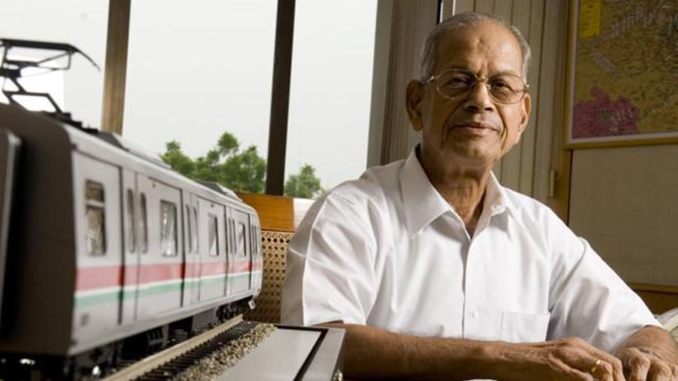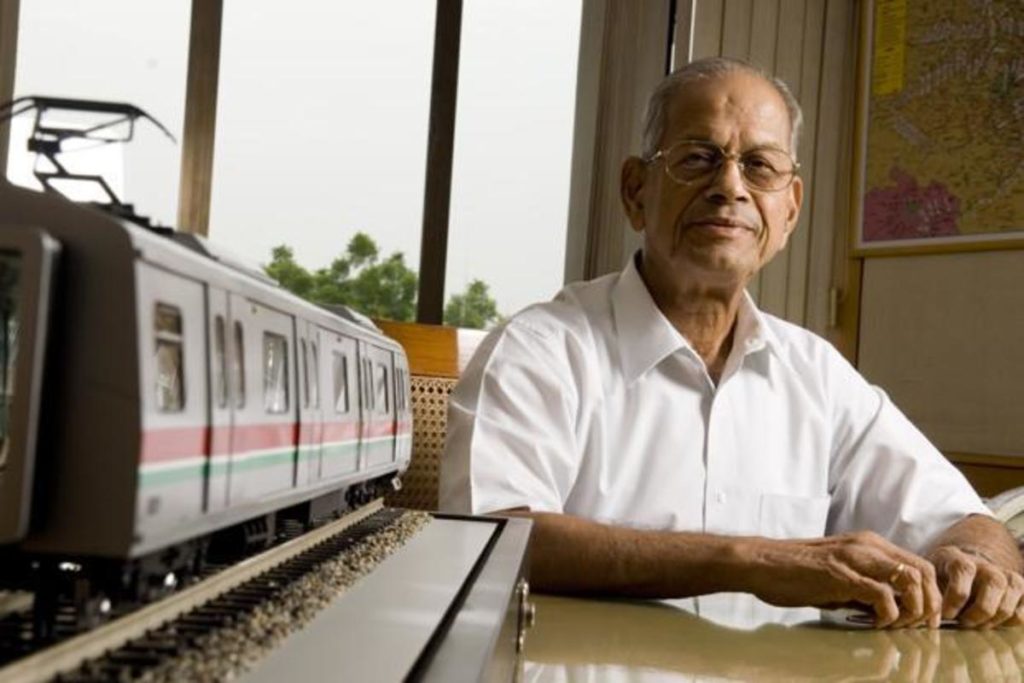
 Mr. E. Sreedharan
Mr. E. Sreedharan
Elattuvalapil Sreedharan is an Indian civil engineer and a retired IES (IRSE) officer popularly known as the “Metro Man”. He is credited for changing the face of public transport in India with his leadership in building the Konkan Railway and the Delhi Metro while he served as the managing director of Delhi Metro between 1995 and 2012.
INTERVIEW with Mr. E. Sreedharan
Rail Analysis India : Please tell us more about your journey with the Metro rail so far. How did you get started in this industry ?
Mr. E. Sreedharan : First phase of Delhi Metro project was sanctioned in August 2005 and a company was registered under the name Delhi Metro Rail Corporation shortly thereafter. An agreement was also signed with Japanese Government for financing 66% of the project cost.
The Government could not find a suitable person to head DMRC even after a search committee was set up, consisting of Secretary, Urban Development, Chief Secretary, Delhi and myself. In Feb 1997, Japanese Government gave an ultimatum to Govt. of India threatening to withdraw from the loan commitment, if a suitable MD was not selected and posted to DMRC. The Govt. therefore hurriedly decided to post me as CMD of DMRC, I was then Chairman–cum- Managing Director of Konkan Railway Corporation. That was how I landed in DMRC as its CMD on 4th Nov, 1997. After successfully completing phase-I of Delhi Metro almost 2 years and 9 months ahead of the schedule, DMRC had the courage and vision to start Metros in other major cities of the country.
“As a result a metro revolution started in the country and today there are 15 cities in India constructing/operating Metro systems.”
Unfortunately, the bace of metro construction in the country is painfully slow. While a country like China is constructing metros at the rate of 300 Kms every year, India is not able to achieve even 25 Kms a year.
In regard to metro construction, the country is almost self sufficient in all areas. Indigenisation has taken place except in the area of signalling. The construction industry therefore has very exciting and wide opportunities in India.

Rail Analysis India : What type of challenges were faced in the construction of the first phase of the Delhi Metro project ? Any interesting stories or anecdotes whilst getting the Mega project up and running ?
Mr. E. Sreedharan : When Delhi Metro was taken up, the country did not have any experienced persons for planning, designing and executing a world class Metro. The expertise was just not available and we had to therefore engage international expertise to assist us. Apart from this, there was no major hurdle.
An interesting turn of event took place when Japanese Govt. stopped funding the project following the Nuclear Bomb testing at Pokhran. Only after a threat that we would go for other sources of foreign funding, Japanese aid was restarted.

Rail Analysis India : How do you view the progress of Metro projects in India now ? What are the new opportunities Indian companies have in this sector ?
Mr. E. Sreedharan : India is urbanising fast. There are already 18 cities in India with more than 3 million population and further 30 cities with more than 2 million. The traffic problems in these cities can be solved only by introducing rail based metro systems which are very safe, reliable, fast and comfortable.
Unfortunately, the bace of metro construction in the country is painfully slow. While a country like China is constructing metros at the rate of 300 Kms every year, India is not able to achieve even 25 Kms a year.
In regard to metro construction, the country is almost self sufficient in all areas. Indigenisation has taken place except in the area of signalling. The construction industry therefore has very exciting and wide opportunities in India.

Rail Analysis India : What are your views about Standardization and Indigenization in Metro Rail Systems and what is the impact of the same on the manufacturing and supply chain of India ?
Mr. E. Sreedharan : Right from the start, I have always stood for standardisation and indigenisation. Unfortunately, this process was very slow.
“The Prime Minister’s call for “Make in India” has certainly given a boost to indigenisation.”
There are now 3 factories manufacturing metro coaches in the country. All civil works (which constitute 55% by value of a metro) all electrical works, track linking etc. all can be now handled by Indian contractors.

Rail Analysis India : Do you think RRTS corridors is another solution after Metro rail for reducing road traffic in Indian cities? What else can the cities do for smoother management of traffic ?
Mr. E. Sreedharan : The roles of RRTs and Metros are different. While metros are urban transport systems, RRTs are high speed rail connectivity to suburbs and neighbouring urban centres. Both will no doubt reduce road congestion since they have capacity of a 9 lane motor way.
For metros to become successful last mile connectivity is important and metro fares have to be kept low so as to attract riders from personalised vehicles. Unfortunately, the current metro policy of Govt. of India does not encourage more metros to come nor make them affordable to the common man. For smooth management of traffic, every city should have an empowered, unified urban transport authority who can coordinate and integrate different modus of traffic.
![]()
Rail Analysis India : What are your opinions about this year budget as the MoHUA has been allocated Rs 17,713.93 crore for executing metro projects across the country, which was Rs 14,264.60 crore in the previous Budget ?
Mr. E. Sreedharan : The budget allocation of MoHUA is too meagre to encourage fast expansion of metro systems in the country. Further, these allocations are misleading as most of them are in the form of “Pass Through Assistance” to facilitate availing external loans. This PTA eventually comes back to the Govt. and so the net outflow is only half of the budgeted amount.
Rail Analysis India : Any Suggestions or thoughts you would like to share concerning new metro projects in India and their approach towards it ?
Mr. E. Sreedharan : The country should have a sound, practical and affordable metro policy. The present policy only ring-fencing the interest of the Central Govt. If all our large metro cities are to have suitable metro net work, in the next 15 years, we have to build metros at the rate of at least 200 Kms a year. How this is to be achieved, how they are to be funded and how they are to be owned and operated, all need a comprehensive and deep study.

I had suggested to MoHUA about 2 years back that a high level technical committee should be set up for this purpose which will also go into the area of standardisation and indigenisation. The aim should be not to make the metro a profitable organisation but implement them fast, on time, within the estimated cost, with a fare structure easily affordable to the common man so that people switch over to the metro from roads.
This interview shall be covered in our March 2019 Edition Magazine with more details on Train 18 . Click Here to advertise in the magazine or know more on the same .

